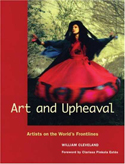Art and Upheaval

Bill Cleveland's career has been focused on the uses of art as a tool for building community and salvaging lives. When I first met him twenty-eight years ago, Cleveland was directing California's newly formed Art-in-Corrections Program. The subsequent three decades of his work and writing have proceeded along a consistent path from this distant root.
His latest book, Art and Upheaval: Artists on the World's Frontlines, documents international artists and projects that Cleveland has encountered firsthand over the past eight years. The breadth and gravity of these encounters is both compelling and sobering:
- Political and social oppression in Cambodia
- Apartheid and AIDS in South Africa
- Sectarian violence in Northern Ireland
- Economic marginalization and racism in Watts
- Ethnic cleansing related to the breakup of Yugoslavia
- Long term effects of British nuclear testing in Australia on soldiers and Aboriginal groups
Cleveland develops each of these situations into a case history chronicling the processes that artists, usually working in groups over extended periods, have used to communicate to a public audience. For each case, the book recounts detailed backgrounds of communities and entire nations in crisis, biographies of the artists, and descriptions of the art works. Many of the cases involve theatrical productions, which are documented through photographs and excerpts from the scripts. In addition to theater, examples of poetry, dance, music, painting, and printmaking are also described.
Although contributed funding is not a featured topic of Art and Upheaval, funders play a part in many, though not all, of the stories Cleveland tells. For instance, in one situation, Cambodia, an American foundation (Rockefeller) plays a significant role, and in several other cases, governmental funding and local trusts are instrumental.
Throughout the book, Cleveland addresses his subject with the voice of a reporter, rarely injecting judgment or descriptions of his personal associations with the artists. In numerous instances, he provides verbatim interview transcripts of conversations with the artists, allowing them to portray their work in their own voices. Despite his scrupulous avoidance of critical judgments and partisanship, however, it is apparent that Bill Cleveland finds moving artistic experiences and genuine heroism in these cases.
For some readers, this book could be used as a how-to manual for organizing a variety of arts projects responding to crisis, but for a much broader audience, Art and Upheaval will serve to validate the importance of artists working outside artistic institutions. In Cleveland's words, these artists “… are doing this to rally or to bring order, to educate and inspire, to entertain, to heal, but most of all, to tell the storythe hidden story, the story denied.”
